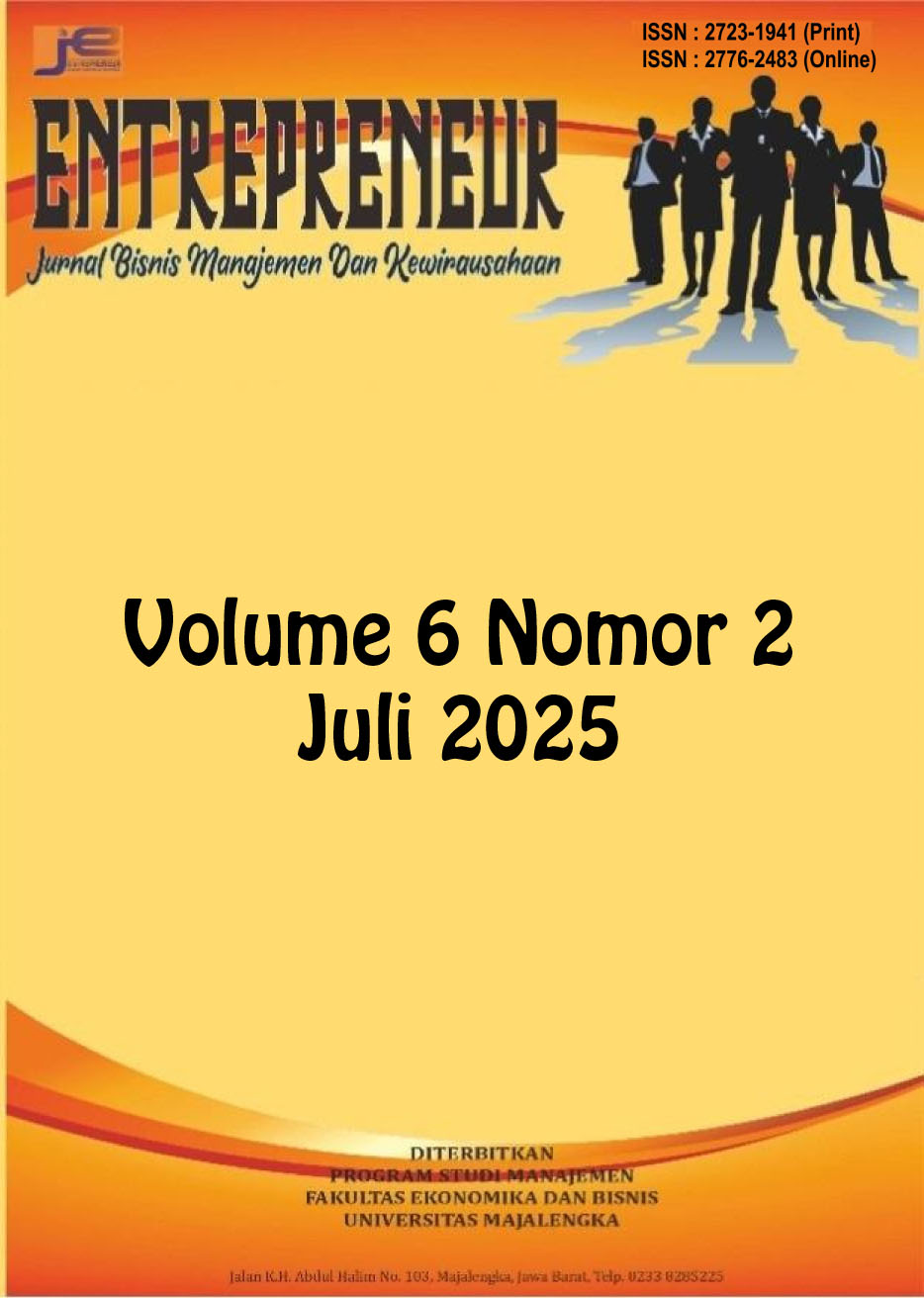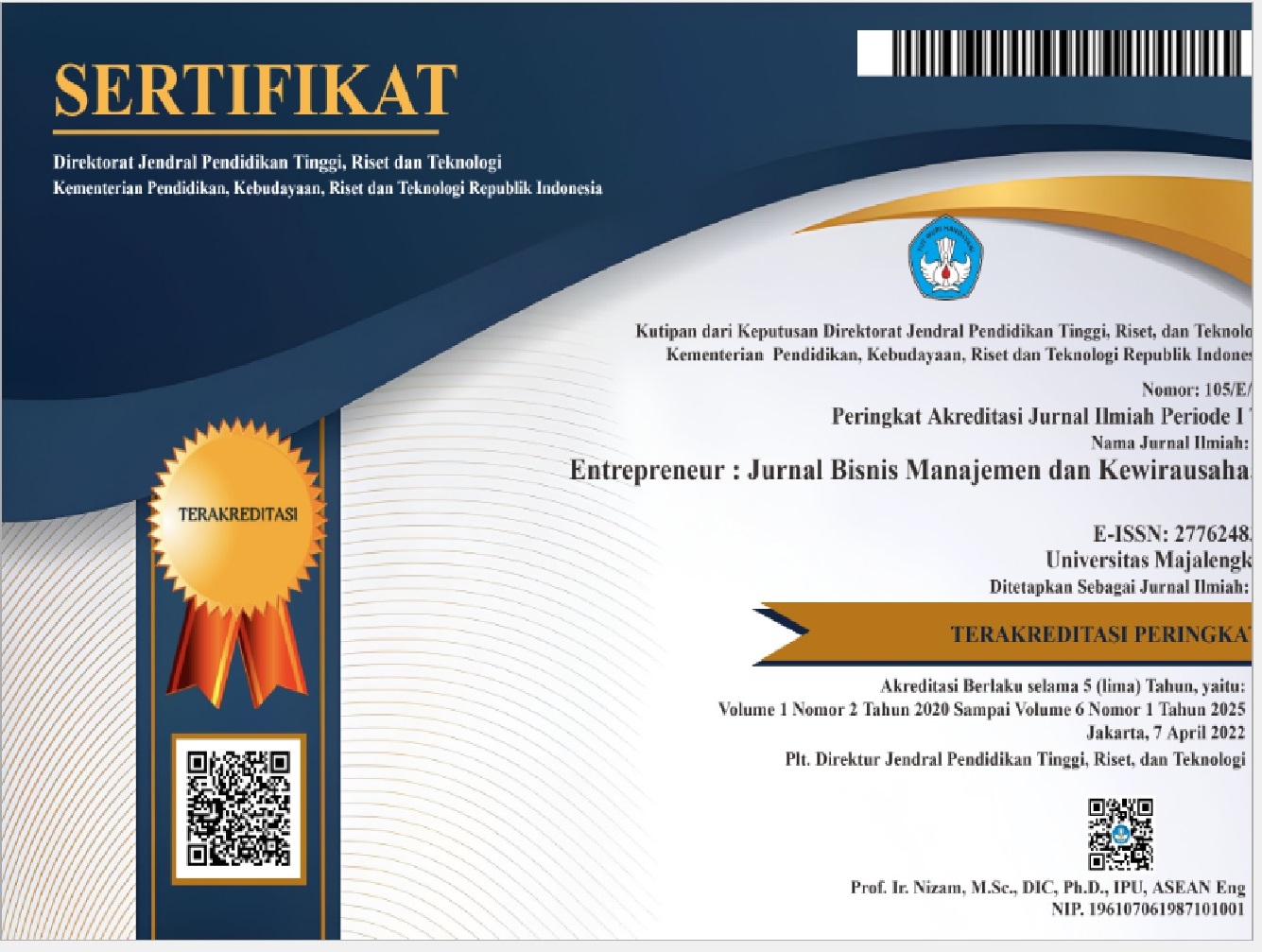Penerapan Ekonomi Sirkular Dalam Penanganan Sampah Di Kabupaten Sumbawa Barat
DOI:
https://doi.org/10.31949/entrepreneur.v6i2.14093Abstract
The increasing volume of waste in West Sumbawa Regency has become a pressing issue, driven by population growth, urbanization, and changing consumption patterns that continue to generate more waste, while the capacity of the Final Processing Site (TPA) is limited and nearing its maximum threshold. This study aims to analyze the current waste management practices in West Sumbawa Regency, examine external factors influencing the application of a circular economy in waste handling using the PESTELC approach, and develop recommendations for a circular economy model in waste management through a descriptive qualitative method, with data analyzed using the Miles and Huberman model and verified through triangulation. The findings reveal that the current waste management system still follows a linear “collect-transport-dispose” model, with the Batu Putih Final Processing Site operating through open dumping and limited waste processing, resulting in inadequate waste management both upstream and downstream. Institutional structures are not yet optimally organized, transportation facilities are insufficient, and the concept of a circular economy has not been implemented. The PESTELC analysis shows that the implementation of a circular economy is still hindered by non-specific policies, limited funding and market access, low public awareness, lack of appropriate technology adoption, and weaknesses in legal frameworks and competition. The recommended circular economy model proposes a transition from the current linear system to a sustainable and collaborative circular system, aimed at improving environmental quality and creating new economic opportunities for the local community.
Keywords:
Economy Circular, Implementation, Waste ManagementDownloads
References
Bhada-Tata, P., & Hoornweg, D. (2012). What a Waste : A Global Review of Solid Waste Management. 1–116. https://openknowledge.worldbank.org/handle/10986/17388
Bob Reynolds. (2022). Effective Strategic Planning with PESTELC Analysis. Retrieved from https://bradyware.com/effective-strategic-planning-with-pestelc-analysis/
Ekarini, D. F., Sakina, N. A., Erpinda, M., & Prasetyo, H. (2024). Problematika impor sampah di Indonesia: Kepentingan politik, ekonomi, atau lingkungan? 1(1). https://doi.org/10.61511/environc.v1i1.2024.464
Ellen MacArthur Foundation. (2019). Completing the picture: How the circular economy tackles climate change. Ellen MacArthur Foundation. https://ellenmacarthurfoundation.org/completing-the-picture
Macarthur, E. L. L. E. N., & Heading, H. E. A. D. I. N. G. (2019). How the circular economy tackles climate change. Ellen MacArthur Found, 1, 1-71.
МУХИНА, Д. В., & ТРЕТЬЯК, Н. А. (2023). Circular economy principles in waste management. Экономика и Предпринимательство, 11(160), 458–462. https://doi.org/10.34925/eip.2023.160.11.087
Miles, M. B., Huberman, A. M., & Saldaña, J. (2014). Qualitative data analysis: A methods sourcebook (3rd ed.). Sage Publications.
Yoğun, K., & Yıldırım, N. (2025). Research and Conceptual Landscape of Food Waste and Business Models in the Context of the Circular Economy: A Literature Review at the Intersection of SDG 2 – Zero Hunger and SDG 12 – Responsible Consumption And Production. Journal of Lifestyle and SDGs Review, 5(1), e04757. https://doi.org/10.47172/2965-730x.sdgsreview.v5.n01.pe04757
Zahra, M. (2017). Presiding over a flood of waste : a case study on a local movement for domestic waste management at the household level, Bandung City, Indonesia. https://lup.lub.lu.se/student-papers/record/8925598/file/8925613.pdf

Published
How to Cite
Issue
Section
License
Copyright (c) 2025 Rita Ekawati, Sri Rahayu

This work is licensed under a Creative Commons Attribution-ShareAlike 4.0 International License.
COPYRIGHT NOTICE
An author who publishes in the Entrepreneur: Jurnal Bisnis Manajemen dan Kewirausahaan agrees to the following terms:
1. Author retains the copyright and grants the journal the right of first publication of the work simultaneously licensed under the Creative Commons Attribution-ShareAlike 4.0 License that allows others to share the work with an acknowledgment of the work's authorship and initial publication in this journal
2. The author is able to enter into separate, additional contractual arrangements for the non-exclusive distribution of the journal's published version of the work (e.g., post it to an institutional repository or publish it in a book) with the acknowledgment of its initial publication in this journal.
3. The author is permitted and encouraged to post his/her work online (e.g., in institutional repositories or on their website) prior to and during the submission process, as it can lead to productive exchanges, as well as earlier and greater citation of the published work







